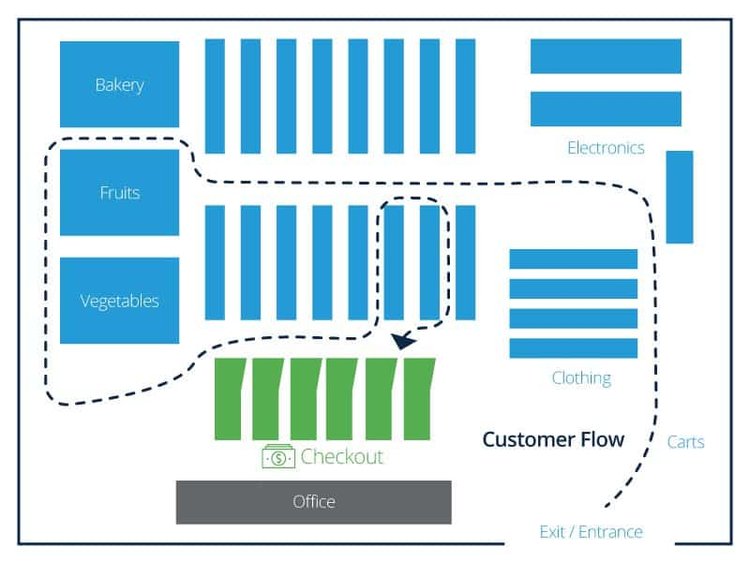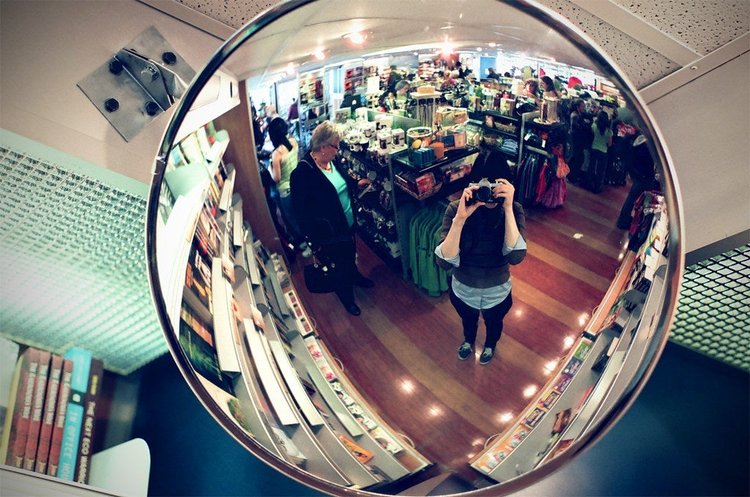These days, smaller brick-and-mortar retailers face several growing challenges: the rise of e-commerce competition, disruption and uncertainty caused by the COVID-19 pandemic, and many others.
Inventory shrinkage due to shoplifting, errors, and fraud cost retailers around $46.8 billion in 2018, so preventing shoplifting is at the top of any retailer's mind.
Below, we go through 10 loss prevention tips to help you limit shoplifting in your retail store.
10 effective ways to prevent shoplifting in your retail store:
- Keep your store organized and tidy
- Know common shoplifting tactics
- Optimize your store’s layout
- Install security cameras
- Add mirrors to your store
- Use customer service as prevention
- Use signage to deter thieves
- Train your employees
- Use retail inventory management tools
- Identify at-risk items
1. Keep your store organized and tidy
An unorganized store is an ideal playground for shoplifters. When items are left in the wrong sections and inventory is not organized well, it’s difficult to identify when products have gone missing.
Making sure products are constantly pulled forward on shelves, for example, makes it easier for staff to notice missing quantities of items, and makes it more difficult for thieves to inconspicuously swipe items from fully-stocked shelves. However, avoid overstocking display shelves or units with too many products, so you can clearly view how much stock is out at any one time.
Embed regular tidying and stock organization tasks into your everyday practices, and even more so during busy retail periods such as Christmas, Thanksgiving, and Black Friday.
2. Be aware of common shoplifting tactics
Shoplifters are constantly coming up with new ways to thieve without getting caught. Knowing the most common ploys and behaviors shoplifters employ will help you be on guard in your own store:
- Working in pairs: One of the oldest tricks in the book, one person distracts sales floor staff while the other pockets goods.
- Hiding products: Shoplifters often hide items in their own clothing, in other items they’ve actually purchased, handbags, strollers, reusable shopping bags, and their shoes.
- Price switching: Shoplifting doesn’t always mean missing items that aren’t paid for. Thieves will also often swap pricing tags or labels from one product to another so they’re charged less for a more expensive item.
- Grab and run: Some shoplifters wait for an opportune moment -- perhaps during a busy period, or when all sales staff appear to be busy -- to dash into your store and run off quickly with items. This is more common in stores that don’t have security guards or don’t have anti-theft alarms placed at the entrance.
3. Optimize your store’s layout
Each store has its own ideas about how to display products and design their floor layout, but there are several ways to optimize store layouts to help prevent store theft.
The most common layouts often place customer checkouts near the entrance/exit, so that all customers will pass it as they leave. This gives staff a good chance of spotting shoplifters before they leave the store, and also serves as a deterrent if thieves know they have one last hurdle to pass before exiting. For example, below, Smartsheet visualizes the common ‘grid’ store layout, which places the checkout at the exit/entrance of stores.

The grid layout is one of the more popular store layouts as it helps customers move easily around the store, but also ensures any shoplifters have to pass the checkout area before leaving. Image source: Author
It’s also important to eliminate any blind spots in the store. This means keeping product displays below eye level, keeping high-ticket items behind lock and key, and making sure your store has good lighting.
4. Install security cameras
Security camera systems have a threefold purpose: they act as a deterrent to shoplifters; they allow staff to monitor the whole store and people who might be acting suspiciously; and if shoplifters do steal, there will be evidence identifying them to help with prosecution.
Installing surveillance cameras can also reduce your insurance premiums in some cases.
5. Add mirrors to your store
Mirrors are great tools to reduce blind spots and increase visibility of both products and people in both large and small stores. You can purchase anti-theft mirrors of all sizes, shapes, and angles of visibility to use in your store. They’re also a low-cost method of shoplifter prevention for retailers on a budget.

Many retailers use mirrors to improve staff visibility of the store floor. Image source: Author
6. Use customer service as prevention
One of the easiest and cheapest ways to prevent shoplifting is by leveraging your customer service practices. Here are some ideas to help use retail management and service techniques in the battle against shoplifters:
- Greet all customers: These days, it’s common practice to position a member of staff at the entrance of the store to welcome all customers. Not only does this set the scene for a good customer experience, but it also lets shoplifters know that they’ve been acknowledged.
- Maintain adequate staffing levels: As we mentioned previously, one common shoplifting tactic is to work in pairs and distract sales floor staff. If you have enough people on the sales floor, thieves will be less likely to steal.
- Ask each customer if they need assistance: Again, not only is this good customer service, but by asking if a customer needs help and letting them know where you’ll be if they do, you’re also showing potential shoplifters that your staff are attentive and not passive.
7. Use signage to deter thieves
Retail stores commonly use signage to make thieves extra aware that the store has taken anti-theft measures. These signs usually inform people of installed cameras, whether the store is part of a local anti-theft group, and that shoplifters can expect to be prosecuted. Again, signs are a low-cost way to let thieves know you are alert and they will face consequences for shoplifting.
8. Train your employees
All staff should know how to spot scams such as price switching and false returns, and they should also know about standard anti-theft protocols, such as the size of bags allowed in your store.
However, your staff should not only be aware of the tricks that shoplifters use to get away with stealing but also how to deal with shoplifters once they’re in the store.
This should include knowing how to alert other members of staff and management of potential shoplifters via a “code” or announcement, knowing when they should and shouldn’t approach suspected shoplifters, and when to alert police and security guards.
Implement a shoplifting policy that details how staff are expected (and not expected) to act when it comes to dealing with shoplifters.
9. Use retail inventory management tools
Good retail inventory management practices will also help minimize shoplifting. Inventory management features found in retail POS systems help retailers track inventory and spot shrinkage patterns.
For example, a retail software system might show that a large number of a certain item has gone missing in the last month, and this item might be both easily swiped, and currently placed in a low visibility area. This kind of information gives retailers insights into how to beef up their retail theft prevention techniques.
10. Identify at-risk items
Your average shoplifter won’t target items such as expensive jewelry or large electronics, instead targeting small, easily swipeable products that are easy to conceal.
Use inventory management tools to identify your most expensive inventory, and work out a plan to protect these items. This can involve placing items in lockable cabinets, placing items close to the counter, or placing them in a highly trafficked area of the store that’s always manned by a staff member.
Keep shoplifters at bay with these 10 tips
Shoplifting is an industry-wide problem, and no store earns a 100% no-theft rate. While you can’t prevent 100% of shoplifting incidents, use these tips to make it more difficult for would-be thieves to successfully steal from your store.
As technology advances, you can leverage software to help prevent shoplifters. Given the cost of inventory, it’s worth investing in systems that can help combat shrinkage and loss due to theft.
Our Small Business Expert
We're firm believers in the Golden Rule, which is why editorial opinions are ours alone and have not been previously reviewed, approved, or endorsed by included advertisers. The Ascent does not cover all offers on the market. Editorial content from The Ascent is separate from The Motley Fool editorial content and is created by a different analyst team.